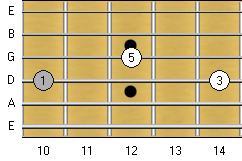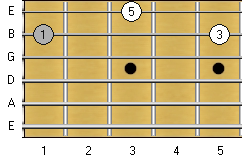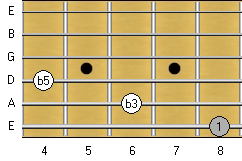In this guitar lesson we’re going to continue our triad arpeggio adventures. To do this we’ll look at how to move the 2-1 Fingerings to new string pairs. We’ll also look at a new memorization exercise, and two other fingering approaches for triad arpeggios. It’s going to be fun—am I the only one who gets excited by triad arpeggios? 🙂
I’m assuming that you’ve already worked through the material that we cover in the first triad arpeggio lesson. If you haven’t, then please do that before beginning this lesson.
Moving The 2-1 Triad Fingerings
As you’ll remember from the previous lesson, we looked at four useful triad fingerings. These fingerings were called 2-1 Fingerings, because they were structured in a way where we played two triad notes on the lower-sounding string and one triad note on the higher-sounding string. This meant that a C Major Triad being played on the thick E-string and A-string would look like this…
C Major Triad: 2-1 Fingering

The great thing is that all the 2-1 Fingerings that we looked at in the previous lesson, can easily be moved to other string pairs. So if we took the C Major Triad shown above and moved it to all the other string pairs, then we would end up with these fingerings…
C Major Triad:2-1 Fingering [A-string and D-string]
C Major Triad: 2-1 Fingering [D-string and G-string]
C Major Triad: 2-1 Fingering [G-string and B-string]
C Major Triad: 2-1 Fingering [B-string and thin E-string]
With the exception of the fingering on the G-string and B-string, all the fingerings are the same shape as the one that you memorized in lesson one. This is awesome news, because this means that a lot of your hard work will automatically help you with the new fingerings. 🙂
Now that we have some new fingerings to learn, let’s take a look at an effective exercise that will help you do this…
Triad Memorization Exercise 2: Practice For 5-Minutes

This exercise involves taking a single triad fingering and then moving it to all the possible string pairs. Although the TAB shows a C Major Triad 2-1 Fingering being moved to different locations, it’s important to realise that you can use this practice method for any triad fingering. So once you’ve mastered the exercise as written, be sure to practice it using different fingerings.
Here are some practice suggestions that will help you get the most out of the exercise…
- Just before you play each bar of the exercise, say the triad name out aloud. This means that for the example shown above you would say “C Major” out aloud.
- Say the chord tone out aloud as you play each note of the exercise.
- Practice the exercise as slowly as you need to, and don’t worry about playing it in time. The goal is to improve your fretboard knowledge. It’s not meant to be an exercise for developing your technique.
- Practice the exercise at least three times a week for five minutes each practice session. I recommend doing this for as long as it takes to totally master the fingerings you are working on. Learning things properly is never a waste of time. 🙂
Two Other Fingering Approaches
One of the things that I really love about the guitar is that there are often multiple ways of playing anything that you might want to learn. (This is a blessing for guitarists who love practicing, learning and experimenting, but it’s a curse for the lazy ones who only want a quick fix!).
Because it’s possible to play triad arpeggios in different ways, what we need to do now is look at a couple of new fingering methods for them. Let’s start with the first one which I call 1-2 Fingerings…
1-2 Fingerings
C Major Triad: 1-2 Fingering
C Minor Triad: 1-2 Fingering
C Diminished Triad: 1-2 Fingering
C Augmented Triad: 1-2 Fingering

As you can see from the diagrams above, with 1-2 Fingerings we are doing this…
- Playing one note of the triad on the lower-sounding string.
- Playing two notes of the triad on the higher-sounding string.
The second method of fingering we’re going to look at now is one that I call 1-1-1 Fingerings…
1-1-1 Fingerings
Using this method means that the triad will now use three strings rather than just two, and you’ll need to play one note of the triad on each string. Let’s check out what these fingerings look like…
C Major Triad: 1-1-1 Fingering
C Minor Triad: 1-1-1 Fingering
C Diminished Triad: 1-1-1 Fingering
C Augmented Triad: 1-1-1 Fingering
A Few Last Words
I hope you’ve enjoyed the last two lessons on triad arpeggios. Although we’ve only just scratched the surface, it’s important not to dismiss what we’ve covered as being too basic. The fingerings from the lessons are extremely useful, and can be used to create many musical ideas. They also lay a very important foundation of fretboard knowledge that will help you with learning more advanced arpeggios like seventh arpeggios.
To get the most out of the two lessons that we’ve just completed, I recommend doing the following…
- Using the two memorization strategies, make sure that you have totally memorized all the fingerings for the triads that we’ve talked about. In other words, be sure that you know the 2-1, 1-2 and 1-1-1 fingerings for all the triad types, on all the possible string groupings.
- Invest a lot of time experimenting with the fingerings. This includes playing them in different keys, and seeing how many musical ideas you can create using them.
Have fun!
Return To: Guitar Fretboard Knowledge Lessons










